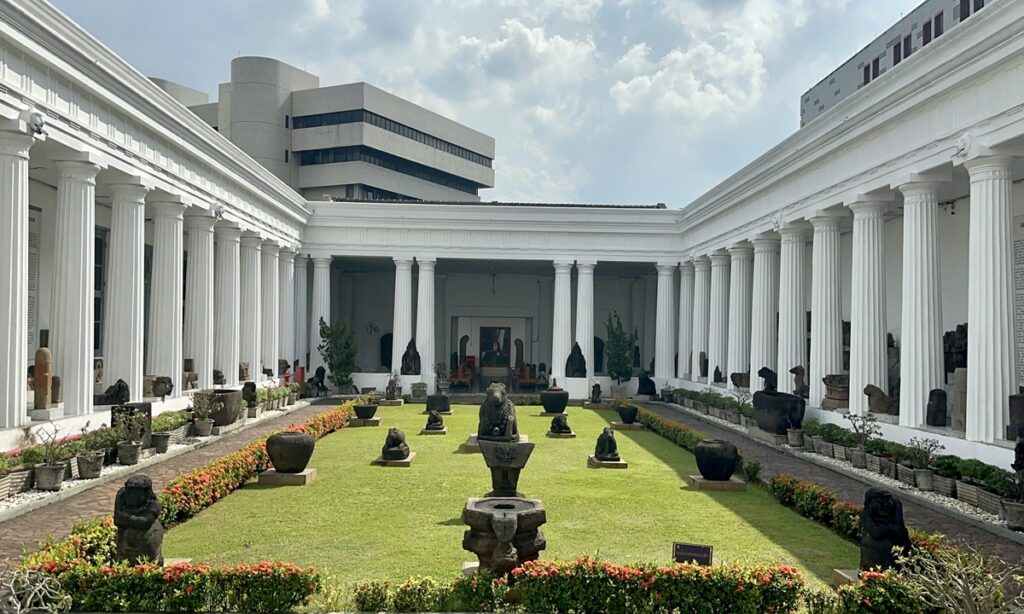Ancient maritime silk road on display
More than 2,000 years ago, fleets of cargo-laden merchant ships set sail from China through the ancient Maritime Silk Road, which opened the path for centuries of trade and cultural exchanges between China and Indonesia.
Indonesia has not only been an important hub along the ancient Maritime Silk Road, it is also where China proposed the 21st Century Maritime Silk Road in 2013, an extension and enrichment of the ancient silk road which constitutes an important component of the Belt and Road Initiative (BRI).
The past and present of BRI now converge at the National Museum of Indonesia, which houses over 8,000 items of Chinese porcelain. A tour of the museum’s ceramics gallery reminds visitors of the hustle and bustle along the ancient road, and shows the great role the “silk road” has played in fostering friendship and exchange between the two neighbors across the sea.
Karamina Puspitasari, a curator at the Public Service Agency for Museums and Cultural Heritage (BLU MCB), told the Global Times that the oldest Chinese ceramic piece at the museum dates back to the Han Dynasty(206BC-AD220).
The National Museum of Indonesia is the largest museum in Indonesia and also one of the most prominent in Southeast Asia. BLU MCB is an organization under Indonesia’s Ministry of Education and Culture, which oversees museums and the cultural heritage in Indonesia, including the National Museum of Indonesia.
According to Karamina, in addition to ceramics, China also sent teas and silk to Indonesia via the ancient Silk Road, while Indonesia transported spices to China. Some ceramics are believed to have been used as containers for the spices.
On the second floor of the museum, an assortment of ceramics produced in China during the Tang Dynasty(618-907) is on display. In 1998, a Tang shipwreck, now known as the Belitung shipwreck, was discovered off Belitung Island in Indonesia, making it one of the most significant archaeological discoveries in recent times.
Over 50,000 pieces of Chinese ceramics were found at the site, predominantly made in Changsha, Central China’s Hunan Province. The large cargo was also indicative of the scale of the trade along the Maritime Silk Road and the variety of ceramics onboard also underscored the vitality and mass production ability of the Chinese ceramics industry.
Karamina noted that during the Ming period, ceramics in China were made “on demand” and targeted wider groups in Southeast Asia. Some of the items, adapting to the Southeast Asian culture, were painted using different hues and local motifs, providing further evidence about the integration of different civilizations along the ancient route. It was also in the Ming Dynasty(1368-1644) that Chinese explorer Zheng He led his fleet to Java, Sumatra and Kalimantan in Indonesia.
Bilateral cultural influence
With ships coming and going, the trading has led to “a lot of exchanges in culture, technology, artistic ideas and lifestyle” along the silk route, Karamina said, with Indonesia serving as a significant “must-pass” transfer point.
For example, Karamina said there are a number of items displaying the mutual cultural learning that took place between Chinese and Indonesians in terms of the shapes and motifs of cultural pieces. “We can observe huge influences from China especially in the coastal area, where contacts happened intensively. The Chinese phoenix was modified into a more Indonesian one there, but the phoenix represents immortality in both the Chinese and Indonesian cultures,” she explained.
Another example is Nyi Roro Kidul, a supernatural being portrayed as the queen of the sea in Javanese mythology. In southern coastal China and even certain countries in Southeast Asia, there is a similar deity called Mazu, a Chinese sea goddess who is believed to protect fishermen and sailors.
In Indonesian batik production, the “Mega Mendung” motif represents auspicious clouds, also a symbolic motif in Chinese painting and porcelain that was introduced to the island of Java in ancient times. Batik refers to the Indonesian technique of wax-resistant dye that is applied to the whole cloth.
“The long-term relationship has helped us to understand each other, keeping the exchanges alive,” Karamina said.
She noted that the influence of Chinese culture is still present, as Indonesia’s language and food have Chinese roots. Meanwhile, trade between China and Indonesia has expanded drastically, from ceramics and spices to smart phones, clothes and almost every product, amid further deepening of bilateral ties under the decade-long development of the BRI.
In 2022, bilateral trade between China and Indonesia rose 19.8 percent year-on-year to $149 billion, making China the largest trading partner of Indonesia for 10 consecutive years, according to the customs data.
Connected by the BRI, the cultural exchanges between China and Indonesia are set to continue the momentum, according to industry insiders.
In 2019, the National Museum of Indonesia brought sculptures and textile collections for display to an exhibition about Asian civilization held by the National Museum of China in Beijing.
Karamina and her colleagues have also been invited to participate to a seminar about the ancient Maritime Silk Road in Shanghai in 2019.
“I’m sure we can have a lot more cooperation in terms of cultural exchanges and archeology because we share a very long history of trade and cultural connection, and we could also do joint research to explore more our cultural similarities,” Karamina concluded.
(Global Times)




